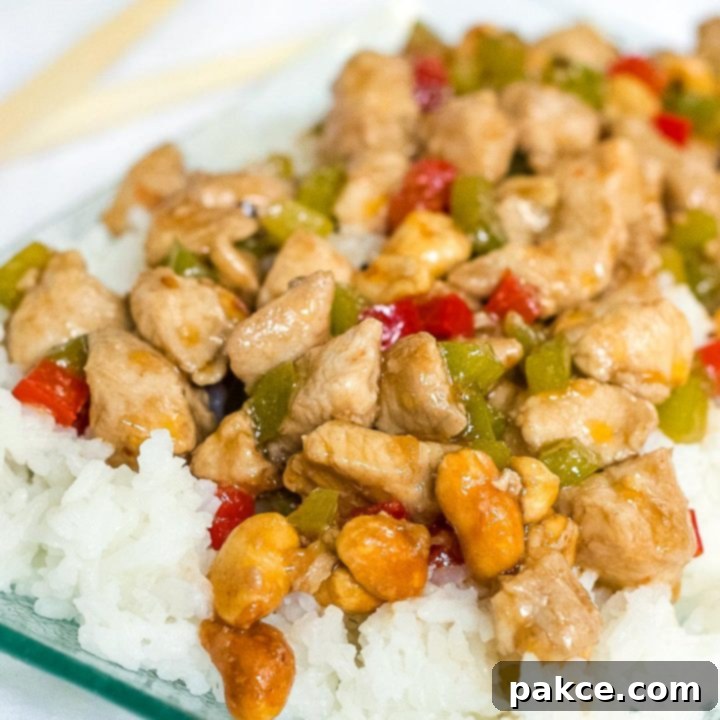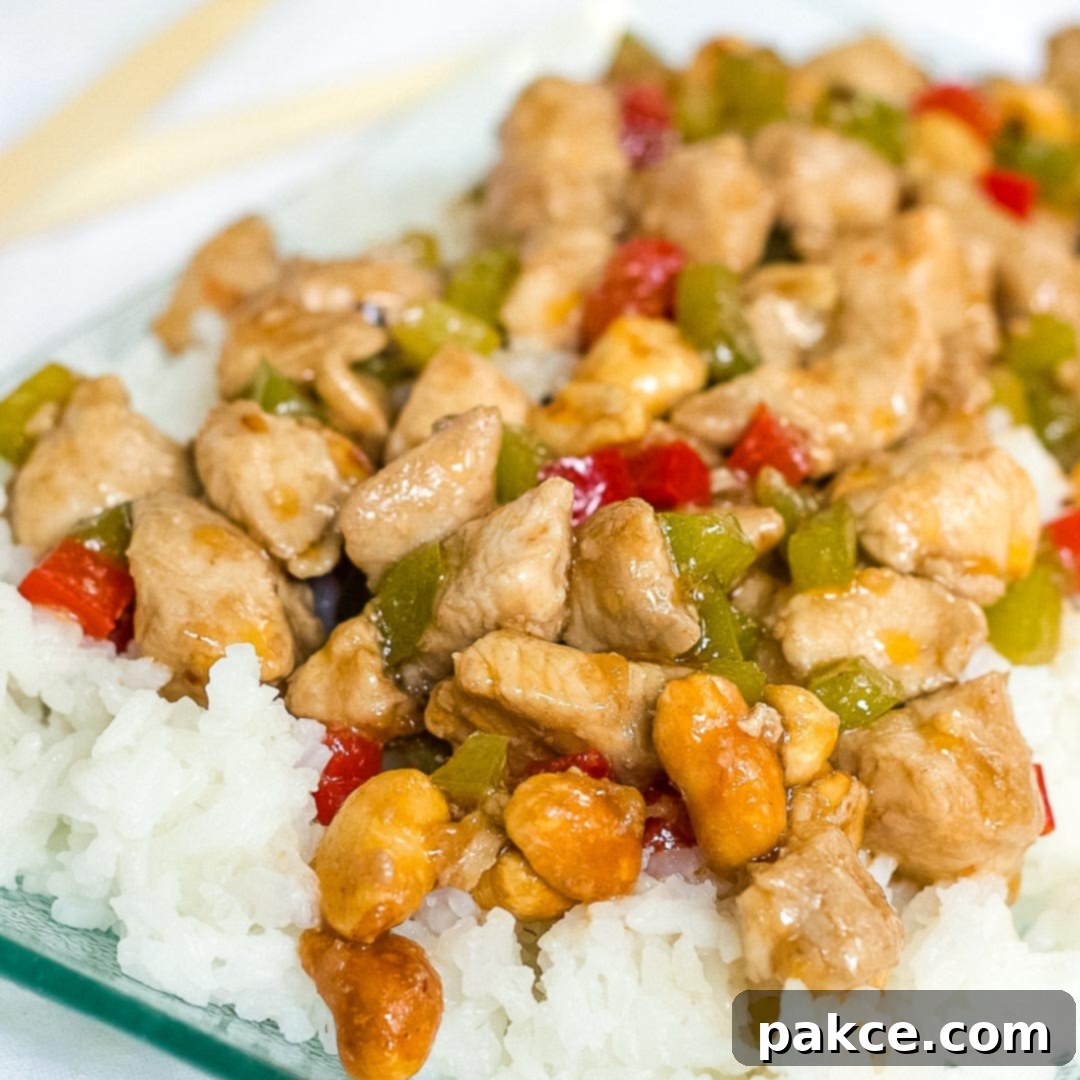Master the Art of Homemade Kung Pao Chicken: An Authentic & Flavorful Recipe
Dive into the vibrant flavors of one of China’s most beloved dishes with our irresistible Kung Pao Chicken recipe. This classic Chinese stir-fry captivates with its perfect balance of savory, sweet, spicy, and tangy notes, coupled with a delightful crunch from roasted peanuts. What truly sets our recipe apart is the carefully crafted chili-flavored oil and the essential overnight marination, ensuring every bite of chicken is tender, juicy, and infused with deep, satisfying taste.
Forget bland takeout! With a little preparation the night before, you can create an authentic Kung Pao Chicken that rivals your favorite restaurant. The secret lies in giving the chicken ample time to soak up the marinade, allowing it to tenderize and absorb all the delicious flavors. When you’re ready to cook, the process is swift and engaging – a true stir-fry experience that brings the magic of Chinese cooking right into your kitchen.

The Irresistible Allure of Kung Pao Chicken
Kung Pao Chicken, or Gōng Bǎo Jīdīng, hails from the Sichuan province of China and is renowned for its bold flavors and aromatic spice. The dish traditionally features diced chicken, peanuts, vegetables, and chili peppers, all coated in a complex sauce that delivers a symphony of tastes. While some versions include Sichuan peppercorns for their unique numbing (má là) sensation, our recipe focuses on creating a deeply satisfying, chili-infused flavor that is both accessible and incredibly delicious.
This recipe is designed to bring that authentic experience to your dinner table with clear, simple steps. It’s not just about throwing ingredients into a pan; it’s about building layers of flavor, starting with the tender, marinated chicken and culminating in a perfectly balanced sauce that clings beautifully to every piece.
Why This Kung Pao Chicken Recipe is a Must-Try
What makes our Kung Pao Chicken recipe stand out from the rest? It boils down to two critical elements that elevate it from a simple stir-fry to a culinary masterpiece:
- Overnight Marination: This step is non-negotiable for achieving the best flavor and texture. Marinating the chicken in soy sauce, rice cooking wine, and cornstarch not only infuses it with savory notes but also tenderizes it, resulting in exceptionally juicy and succulent pieces that cook up quickly in the wok. This preparation truly makes all the difference, creating a depth of flavor you won’t get from a quick marinade.
- Homemade Chili-Flavored Oil: Instead of relying on pre-made chili oil, we guide you through infusing your cooking oil with dried chilies. This process, where the chilies are stir-fried until they turn black, releases their full, aromatic potential directly into the oil, forming the spicy and fragrant base that defines authentic Kung Pao Chicken. It’s this fresh, custom-made chili oil that provides the dish’s signature kick and aroma.
Beyond these highlights, our recipe offers a harmonious blend of textures from the tender chicken, crisp bell peppers, and crunchy peanuts, all bathed in a rich, glossy sauce. It’s a meal that’s hearty enough for a main course and versatile enough to be adapted to your preferences.
Recipe

Kung Pao Chicken
Add to Shopping ListGo to Shopping List
Ingredients
Marinade
- 2 tablespoon soy sauce
- 1 tablespoon rice cooking wine
- 1 teaspoon cornstarch
Sauce
- 1 boneless skinless chicken, cut into bite sized pieces
- 2-4 small dried chilies
- 1 tablespoon fresh ginger, minced
- 2 garlic cloves, minced
- ½ C peanuts
- 1 tablespoon cornstarch
- 1 tablespoon sugar
- 1 green bell pepper, diced
- 1 red bell pepper, diced
- 2 tablespoon soy sauce
- 2 tablespoon sesame oil
- 1 teaspoon rice cooking wine
- 1 tablespoon vinegar
- 6 tablespoon oil, divided
Instructions
-
Marinate chicken overnight in a mixture of 2 tablespoon soy sauce, 1 tablespoon rice cooking wine, and 1 teaspoon cornstarch.
-
To make the sauce, combine the following in a small bowl: vinegar, 2 tablespoon soy sauce, sesame oil, 1 teaspoon rice cooking wine, sugar, 1 tablespoon cornstarch. Set aside.
-
Heat 4 Tbsp. oil in a wok over high heat. Cook chicken until cooked through and remove to a plate and set aside.
-
Rinse out wok and add 2 tablespoon oil. Heat oil and add chilies. [If you cannot find chilies, you can use ¼ to ½ tsp. crushed red pepper.] This makes chili oil and is what flavors the dish.
-
Stir fry chilies until they turn black, add ginger, garlic, and peppers. Stir fry until softened.
-
Add chicken to reheat. Add sauce and stir until thickened.
-
Garnish with peanuts and serve over rice.
Notes
You can use low-sodium soy sauce if you prefer.
Nutrition per serving
Share
Pin
Tips for the Perfect Kung Pao Stir-Fry
Achieving a restaurant-quality stir-fry at home is easier than you think with a few key techniques:
- Mise en Place is Key: “Mise en place” is a French culinary term meaning “everything in its place.” For stir-frying, this is crucial. Have all your ingredients prepped – chicken marinated, sauce mixed, vegetables diced, aromatics minced – before you even turn on the stove. Stir-frying is a rapid process, and you won’t have time to chop or measure once the cooking begins.
- High Heat is Essential: A wok or large skillet needs to be very hot before adding ingredients. This ensures a quick sear on the chicken and vegetables, locking in flavors and creating that desired slightly charred, smoky taste. Don’t be afraid to let your wok get smoking hot!
- Don’t Overcrowd the Pan: Cooking in batches, especially the chicken, prevents the temperature of your pan from dropping too much. Overcrowding leads to steaming rather than stir-frying, resulting in soggy chicken and vegetables. Cook the chicken in a single layer, giving it space to brown nicely.
- Rinse the Wok: As mentioned in the recipe, rinsing the wok between cooking the chicken and the aromatics is important. This cleans out any burnt bits or excess marinade, preparing a fresh, clean surface for the chili oil and vegetables to truly shine without any unwanted flavors.
- Stir Continuously: The name “stir-fry” says it all. Keep your ingredients moving constantly to ensure even cooking and prevent sticking or burning.
Customizing Your Kung Pao Chicken
This recipe provides a fantastic base, but don’t hesitate to make it your own! Here are some ideas for customization:
- Adjusting Spice Levels: If you love more heat, add a few more dried chilies to the oil. For an authentic Sichuan kick, consider adding a teaspoon of Sichuan peppercorns along with the dried chilies to the hot oil. For milder palates, use fewer chilies or omit them entirely, replacing them with just a pinch of crushed red pepper flakes.
- Adding More Vegetables: Feel free to incorporate other quick-cooking vegetables like diced onions, carrots, zucchini, snow peas, or broccoli florets. Add them to the wok with the bell peppers and stir-fry until tender-crisp.
- Protein Alternatives: While chicken is traditional, this sauce works wonderfully with other proteins. Try it with diced pork, sliced beef, shrimp, or even firm tofu for a vegetarian version. Adjust cooking times as needed for different proteins.
- Sweetness and Tanginess: Taste the sauce and adjust the sugar or vinegar to suit your preference. Some like it sweeter, others prefer a tangier finish.
- Nut Variety: While peanuts are classic, you can experiment with cashews or almonds for a different nutty flavor and crunch.
Serving Suggestions
Kung Pao Chicken is a meal in itself, but it pairs perfectly with a few simple accompaniments:
- Steamed Rice: Fluffy white rice is the quintessential pairing, soaking up all the delicious sauce. Brown rice or jasmine rice also work well.
- Noodles: Serve it over lo mein or rice noodles for a heartier meal.
- Side Vegetables: A simple side of steamed or stir-fried broccoli, asparagus, or green beans can add freshness and balance.
- Appetizers: Begin your meal with spring rolls, egg rolls, or a light cucumber salad for a complete Asian-inspired feast.
- Soup: A comforting bowl of egg drop soup or hot and sour soup complements the flavors beautifully.
Storage and Reheating
Leftover Kung Pao Chicken is a treat! Store any leftovers in an airtight container in the refrigerator for up to 3-4 days. To reheat, gently warm in a skillet over medium heat, adding a splash of water or chicken broth to loosen the sauce if it has thickened too much. You can also microwave it, though the texture of the chicken and vegetables might be slightly softer. Adding fresh, roasted peanuts upon reheating can help restore some of the crunch.
Frequently Asked Questions (FAQ)
- Can I use chicken thighs instead of breasts?
- Absolutely! Boneless, skinless chicken thighs are often preferred for their juicier texture and richer flavor. They hold up very well to stir-frying and marinating.
- What if I don’t have rice cooking wine?
- If you don’t have rice cooking wine (Shaoxing wine is ideal), a dry sherry is the best substitute. In a pinch, you can use a small amount of dry white wine or even chicken broth, though the flavor profile will be slightly different.
- How can I make this recipe gluten-free?
- To make this Kung Pao Chicken gluten-free, substitute tamari for soy sauce and ensure your rice cooking wine (if using) is gluten-free. Cornstarch is naturally gluten-free.
- Is Kung Pao Chicken supposed to be very spicy?
- The spice level is adjustable! Traditional Sichuan Kung Pao can be quite spicy, but you can control the heat by varying the number of dried chilies you use. Start with fewer chilies if you prefer a milder dish and add more next time if you crave more fire.
- Can I prepare any components ahead of time?
- The chicken marination is designed to be done overnight. You can also dice your bell peppers and mince your ginger and garlic a day in advance, storing them in separate airtight containers in the refrigerator. The sauce mixture can also be prepared ahead of time and kept in the fridge.
Conclusion
This homemade Kung Pao Chicken recipe offers a truly rewarding culinary experience, bringing authentic Chinese flavors and techniques right into your kitchen. The combination of tender, marinated chicken, aromatic chili oil, and a perfectly balanced sauce makes for an unforgettable meal that’s both exciting and comforting. Whether you’re a seasoned chef or a home cook looking to explore new cuisines, this recipe is designed to be accessible and utterly delicious. Gather your ingredients, prepare your wok, and get ready to enjoy a masterpiece that’s far superior to any takeout.
Don’t forget to share your culinary creation with us! We love seeing your homemade dishes. Happy cooking!
